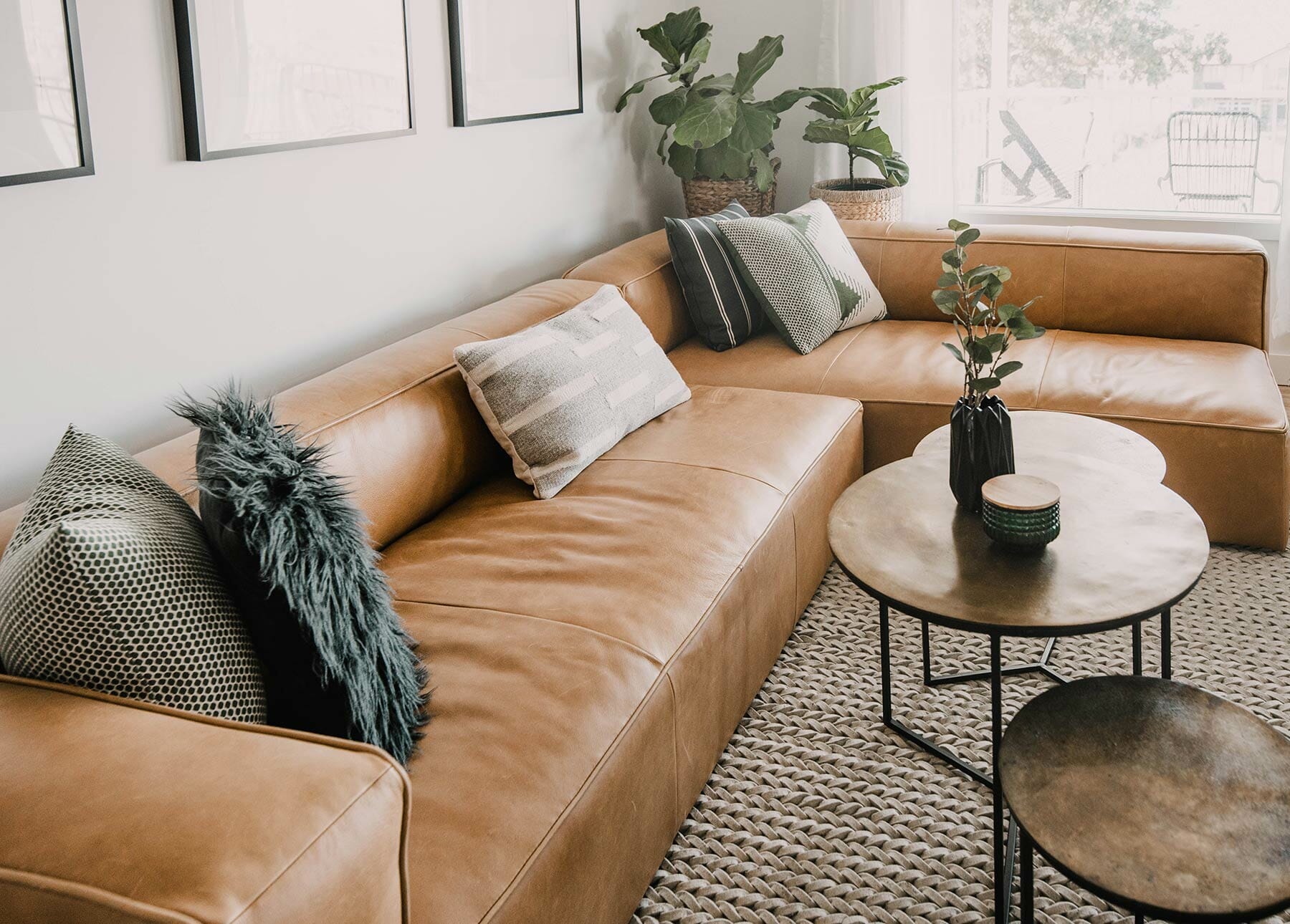How to Choose & Care for Leather Furniture
Meet the Materials
When you think of leather, you might picture a lumpy recliner in the corner of a dark and smoky man cave. You may also be thinking of a certain popular book series. That’s not the kind of leather education we specialize in, but we empower you. Wherever your mind goes, we’re here to not only provide you with an easy-to-understand leather education. We’re also here to guide you as you try to find the perfect leather furniture piece for your space.
As you probably know, leather is made from the cured, tanned hides of cattle. However, things get a bit trickier after that. If you’ve ever shopped for leather before your mind has experienced the confusing swamp of terms like grain, genuine leather, and whatever the heck “aniline” means. Navigating the leather world can be all-consuming, so we’re here to help break things down for you in a way that’ll leave plenty of room in your brain for other non leather-related things.
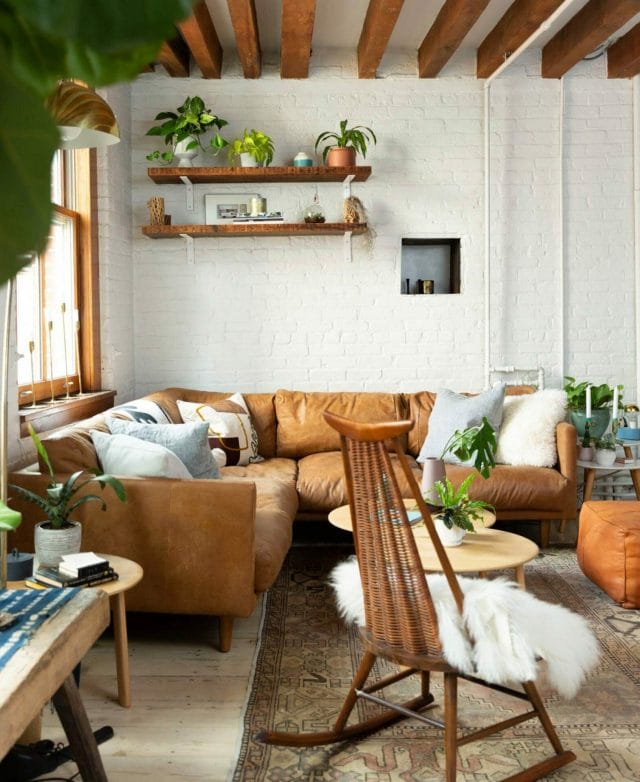
Why Real Leather?
We always strive to keep it real here at Article. When it comes to leather, we believe in using the real deal. We carefully select our natural materials to build quality pieces that last. And boy, does real leather last.
Real leather is durable, strong, and can stick around for decades if cared for properly. If you’ve ever been to an antiques auction you might have noticed timeless leather pieces that don’t look a day over 20. If only we all aged this well.

If you’re a germaphobe or battle pesky dust allergies, leather is your bff. Leather doesn’t hold onto dust mites, pet hair, or anything else that might be floating around your home (let’s not think about that too much) — meaning it’s the most hygienic upholstery option. You’ll be cleaning it less often and more easily, which helps avoid the constant rubbing and scrubbing that tends to wear fabrics out. Breathe easy.
While we’re on the subject of breathing, we can’t forget about the smell of real leather. There’s a certain rich and earthy scent that can instantly transport you to the Italian countryside. Not to brag, but the majority of our leather is sourced from South America or Europe and refined in Italy. We don’t like waste. That’s why all of our leather is sourced from food-byproduct. Waste not want not.
That said, we totally get if leather isn’t your thing. We respect those who might not be on-board with the use of animal products — no matter what the reason. For anyone seeking alternatives, we’re happy to offer non-animal-based upholstery options as well as down-free styles. That’s something we can all get… down… with.
It’s a Look: Grain
Now we’re getting into the good stuff: grain. This is the kind of knowledge you’ll be able to whip out to impress a first date. Okay maybe not, but it will definitely help you pick out the best leather furniture for your home.

When chatting about leather, grain refers to the amount of “correction” — the sanding process that buffs out natural markings, like bug bites or scars — the material has undergone. Different grain levels will result in different looks, so it’s important to understand what it is you want from your leather.
Let’s break it down.
Corrected: corrected leather has undergone a sanding process that buffs out many of the natural variations seen with full-grain leather. This results in a leather that is less varied but still strong and durable — like with our Sede dining chair. Corrected leather will have less or none of the natural markings that full-grain leather has which allows for a more uniform look. Much like an episode of The Real Housewives, corrected leather will have no scars, wrinkles, or stretch marks.
Top grain: all leather. As we mentioned above, the top grain description doesn’t mean the leather is better quality or superior to other leathers. It’s just a way to refer to the top part of the skin. Your skin is the top grain leather of your body, for example.
Full-grain: full-grain leather has not undergone any correction and is the most natural-looking leather (seen with our Timber Sofa). You’ll get to see the beautiful variations in tone along with unique markings like insect bites, sun spots, and stretch marks that developed over the course of the animal’s life. With full-grain leather, you’re getting a one-of-a-kind piece with a visible history.
As full-grain leather absorbs the impact of everyday life (natural wear, body oils, water, dirt, moisture, etc.) it will develop a gorgeous patina. This results in a vintage, fashionably worn-in look that many designers and influencers aim for.
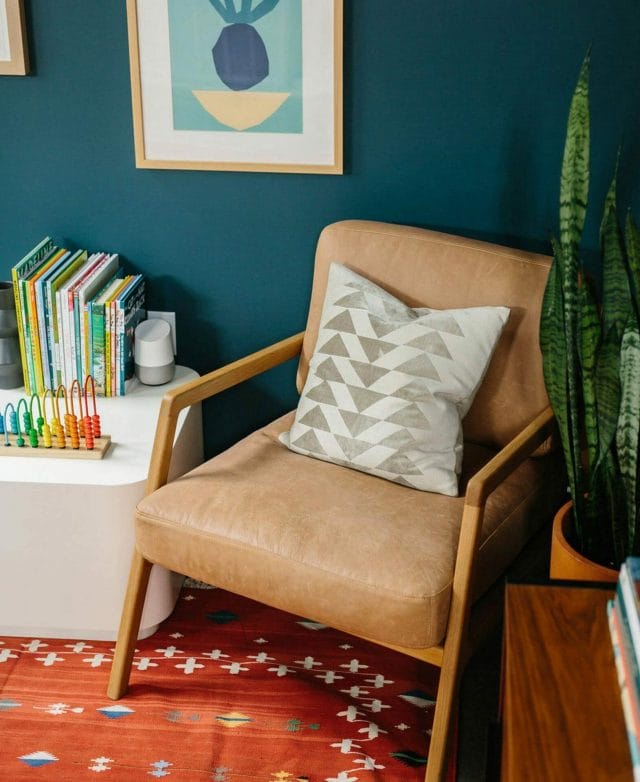
To Dye For: Aniline
While it might sound like the name of a cartoon French boarding school student, aniline refers to the dying process a leather hide goes through after it’s been tanned. When shopping for leather furniture you might have seen the material described as aniline or semi-aniline but probably didn’t give it much thought. Until now.
Different levels of aniline will result in different looks so it’s important to understand what each of the terms means.
Aniline or full-aniline: aniline leather uses no pigment and has no corrections. All the beauty and natural characteristics of the leather are captured and celebrated (like with our Sven Sofa). It’s buttery soft, supple and will develop a unique vintage patina over time (AKA your friends will get more jealous every time they visit). From now on my aging process will also be known as a patina.
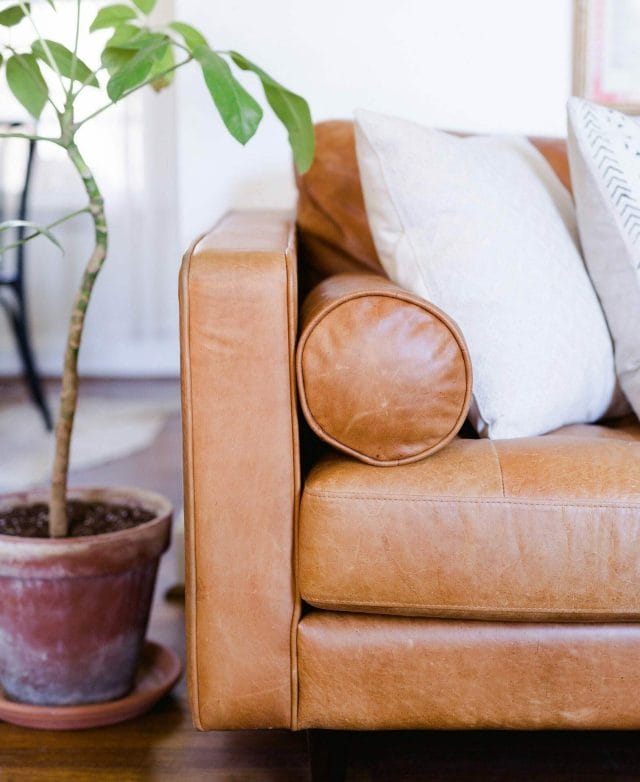
Because it has undergone less processing, potential damage like scratches, direct light, and stains can affect the leather without proper care. The difference between it developing a stunning patina — the vintage, fashionably worn-in look that many designers and influencers aim for — and it simply being worn out, is the right level of care. We’ll get more into how to take good care of your leather later on.
Semi-aniline: some semi-aniline leathers have a thin layer of wax applied after the dying process. This second application of wax results in higher color uniformity (as seen on our Alcott Oxford sofa). This is also good news for your sloppy joe night. The second coating of dye makes the leather less porous and less susceptible to stains and damage. Honestly, my semi-aniline leather couch will age better than me (and I’m okay with that). If that vintage patina look isn’t your thing, semi-aniline leather was made for you. The leather will maintain its color and is less likely to fade in direct sunlight. No sunscreen required.

Leather Myths, Busted
Anyone who’s ever researched leather before has probably been bombarded and bamboozled by some common beliefs and buzzwords. There are tons of articles with contradicting info out there, so we’re here to help dispel some popular leather myths.
Myth #1: Genuine Leather. What Gives?
While it sounds fancy, the word “genuine” is more commonly used as a marketing spin that conceals the poor quality of these leathers.
If you saw a carton of eggs labeled “genuine eggs” you’d probably be more suspicious. What are they hiding? Why are they overselling these eggs? Why am I having an existential crisis in the egg department? Just like a carton of eggs doesn’t need to be labeled “genuine eggs,” leather labeled as “genuine” should give you some pause.
As mentioned in our leather versus fabric sofa showdown post, “genuine leather is typically just layers of cheap leather bonded together with glue.” The result is a surface layer thickness of less than 0.15 millimeters (or 0.0059 inches). In other words, very thin. A genuine disappointment.
Myth #2: Top Grain Leather is Best
As we’ve mentioned, you’ll often see leather labeled as “top grain,” or claims that this type of leather is of the highest quality. Spoiler alert: this isn’t true. The top grain is the outermost part of the skin. All of Article’s leather is top grain leather.
Myth #3: Pigmented Leather is Low Quality
We’re not sure what pigmented leather ever did to them, but someone keeps spreading the rumor that this type of leather is low quality.
We’re taking a stand and officially fighting against these claims. Pigmented leather is simply corrected leather that has been treated with a higher quantity of, well … pigment. It appears more uniform in color and will hold up beautifully in high traffic areas like dining rooms, busy commercial spaces like doctors’ waiting rooms, or anywhere with children. With pigmented leather (like that of the Sede chair) your modern dining room seating actually stands a chance against Junior’s dinner time artistic expression.

The Right Leather Furniture for You
Now that you know your grains from your anilines, it’s time for some leather matchmaking. Which type of leather is best for you? Your home’s style and other factors like whether you have pets, kids, or two left feet will determine which leather you swipe right on.

Find Your Style
Leather used to be reserved for stuffy and formal situations. Picture the British upper-class smoking cigars and drinking cognac in their dark wood and leather library. Times have changed: these days there’s a leather for every style.
Because it’s beautifully natural, leather will often have scars, creases, and color variations. We find that these represent leather’s unique character and appeal — however, rustic isn’t everyone’s vibe. Article works with leathers that offer a more modern, consistent look too (we’ll get more into those later).

Trying to find your style can feel impossible (who am I!?) but there are a few questions that can help guide you in the right direction:
When you picture the perfect room, what does it feel like? Is there a relaxed and airy vibe or are things darker and more serious? If you lean towards a casual California-boho type of look, a full-grain and aniline leather (natural variations, no corrections — patina ready) is your go-to. If you’re thinking you want more order in a minimal and highly intentional space, you’ll probably want leather that’s corrected and/or semi-aniline (natural variations buffed out for a more uniform look, dyed for color consistency).

What do my favorite spaces have in common? Take a look at your Pinterest boards, the magazine cutouts you hoard in a totally normal way, and the interior design photos you like on Instagram: notice recurring themes. Are there colors and materials that appear again and again? Use these patterns to inform your style decisions. If you find yourself making the heart-eyes emoji at rattan, light woods, and different shades of airy neutrals you’ll probably love aniline, full-grain leather (no corrections — a super natural option that is a little more rugged). If your feeds are full of darker woods, metals, clean lines, and concrete, you might drift more towards corrected and pigmented or semi-aniline leather (an option that is more uniform in color and less susceptible to showing wear).
Your Lifestyle
Pets, kids, klutzes. The pieces of your life’s puzzle have a big impact on your leather choices.
While all leather is a great choice for pets and families, it’s important to know what you can expect from the different grains and dyes. Leather of all kinds will be much less porous than fabric so won’t absorb that puppy or baby food mess with the same kind of thirst. We’ll get more into the art of cleaning and maintaining leather later, but for now want to focus on making good choices.
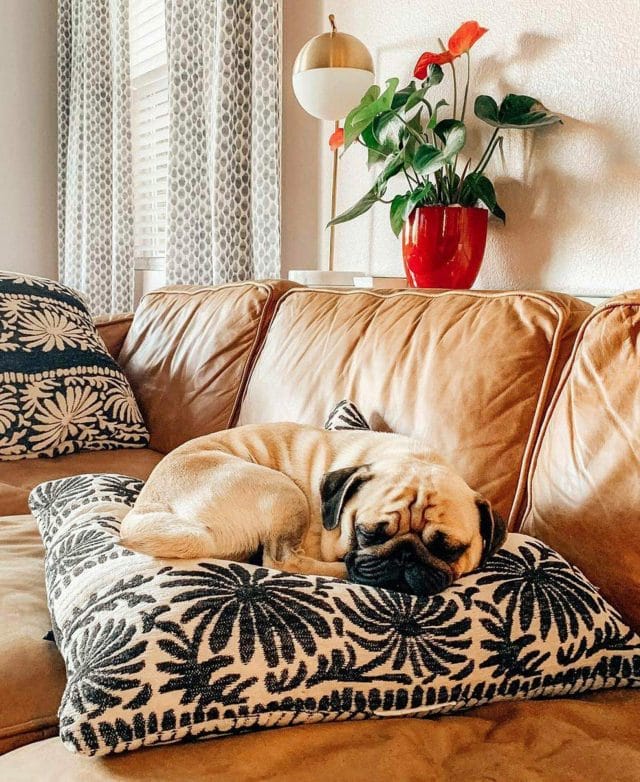
If you’re trying to decide what leather is best for your current and future lifestyle, some questions can help:
- Do you have kids? Those little rugrats can wreak havoc on furniture. It’s as if they don’t understand the value of full-grain aniline leather. I know many parents who refuse to buy new furniture until their kids stop using the couch as a giant kleenex, but you don’t have to live this way. All leather is easier to clean than fabric furniture, but a semi-aniline or pigmented leather stains and marks less easily than full-aniline so will stand up even better to those tiny terrors… I mean, blessings.
- Are you a cat person or a dog person? There’s no wrong answer — or wrong leather. If you’re wanting a more lived-in and vintage look, you’ll love how aniline leather will be like a little scrapbook of your pet’s life. You’ll get to see all the cute little drool mark stains and scratches (aw). If your goal is to keep things looking more like they did on the day you bought them, or know your pup is extra-rambunctious, a semi-aniline piece might be better suited for you. That said, even the most attentive efforts can’t keep your couch perfect forever. But sofas are for living on anyways, right? For even more information on living with pets and leather, check out our post Leather Couch with Dogs.
Our Leathers
Okay, so now you know way more about leather than you ever thought you would (you’re welcome). You understand the differences between the dyeing methods and finishing techniques, and want to put your knowledge into practice and actually see the leather in action. We can help.
In addition to a rainbow of colors such as Tan, Black, Chocolat, Charcoal, Oxblood, Blue, Gray, and beyond, we at Article also have distinct leather categories. Continue reading to discover which is best for your unique needs and style.
Full-Aniline
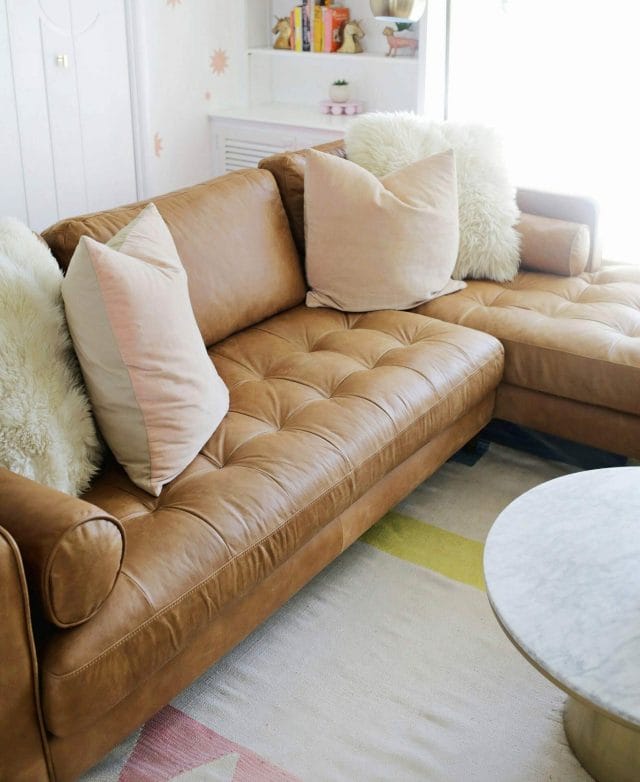
Our full-aniline leather is the classic popular kid. Loved by many, often misunderstood. In this case, it’s the changes in color that seems to baffle people. It’s a full-grain, full-aniline leather which — as you now know — means it’s highly variable in tone, texture, and natural markings. Because it’s the most natural option available, no two pieces will be the same.
Bonus: over time you’ll be rewarded with a beautiful patina.
Canyon
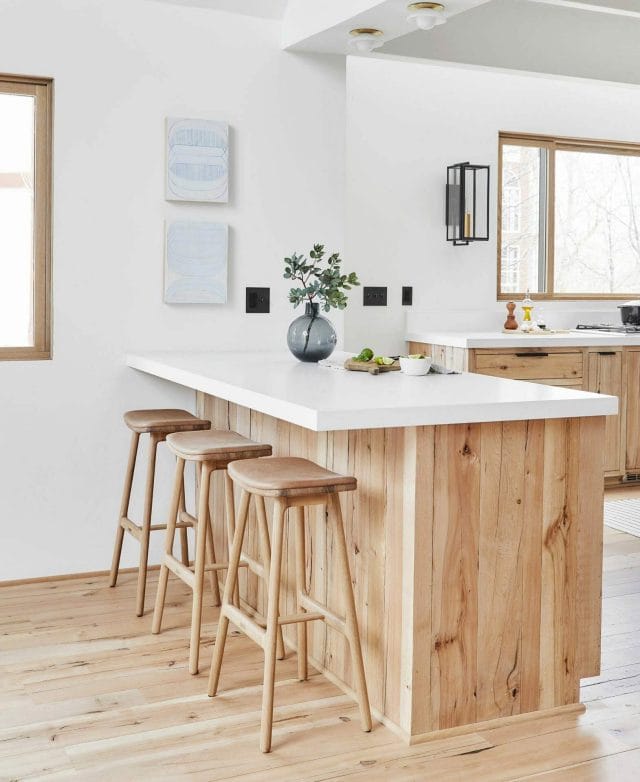
Grand, it is. Canyon is a full grain, full-aniline leather that’ll have you swooning over it’s buttery soft feel. You’ll get beauty and comfort in one thanks to the natural grain and resulting patina.
Each piece of furniture made with Canyon leather will be unique and show the color variations that occur in nature. Our Canyon leather furniture looks right at home anywhere, but feel especially comfortable in casual and relaxed spaces.
Rawhide

No, this isn’t a dog treat. Rawhide is a thick, full-grain, full-aniline leather that has us nostalgic for worn-in baseball gloves. This particular leather is finished with a paraffin wax which produces an extremely rich look and a soft surface. What makes our Rawhide leather extra special is its unique “pull-up” effect.
Pull-up leather is aniline leather that has been lovingly stretched and pulled, a technique that causes the color to migrate and become lighter in certain areas. Pull-up leather feels as soft as your skin after a good exfoliating facial, and will develop that beautiful natural patina we know and love.
This deep brown leather is easily marked and nicked, but we find that scuffs and dings give you that coveted patina even faster — so have at it.
Dakota
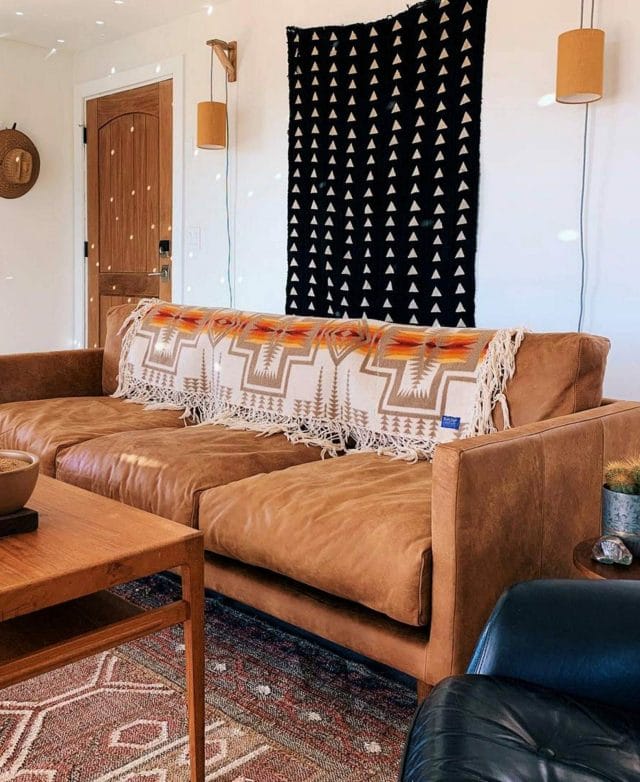
Dakota is a semi-aniline, full-grain leather for all of our inner cowboys. If you’re looking for something distressed and matte, Dakota is your friend. The hide’s natural markings are more pronounced for a truly varied and vintage rustic-chic appearance. Its beautiful layered coloring is thanks to the semi-aniline process where a good sanding provides a wonderfully worn effect.
Despite its aged appearance, a wax seal means it’s one of our most durable and hardworking leathers. Fort building, toddler parkour, and hyper dogs? Yeehaw
Semi-Aniline

Semi-aniline leather has a slightly mottled and matte effect. The color variations of this leather appear more uniform — as if the leather has a thin layer of makeup on. But don’t worry: the texture of the leather hide is still visible. You won’t see every mark as easily as you would with a full-aniline piece, so the occasional dinner on the couch is cool.
With semi-aniline leather, that extra layer of protective wax provides a little stain insurance. With it, you’ll have a few more precious seconds to grab a dishrag (or your shirt, we don’t judge) to wipe up that stain. Phew.
Bella
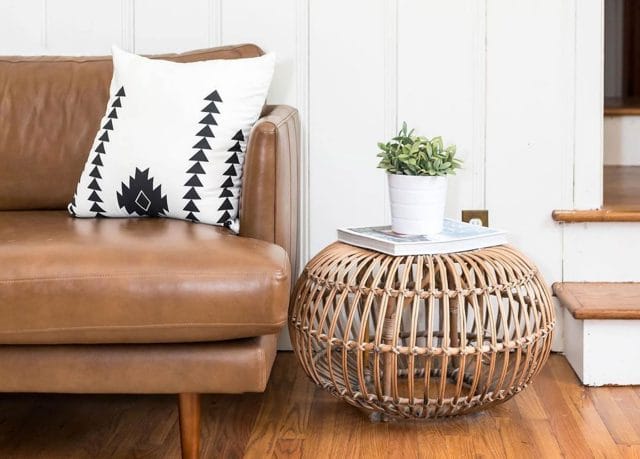
Bella means ‘beautiful’ in Italian, which makes it the perfect name for this type of leather. A semi-aniline leather, there will be minimum color and texture variations. Durability, on the other hand, will be cranked to the maximum.
Bella leather is perfect for high traffic areas and anywhere you foresee spills happening (wouldn’t that be a great superpower?). It’s also less susceptible to fading in direct sunlight, so you can enjoy that afternoon light.
How to Clean and Care for Leather Furniture
Like your own skincare routine, your leather deserves care and attention to stay looking its best. While there aren’t any giant Hannibal-style sheet masks available, there are certainly ways to clean and maintain your leather furniture to keep it so fresh and so clean. Like damage to other fabrics, damage to leather is generally irreversible. In other words, you’ll end up with a permanent reminder of why you can’t have nice things.

Just like you might use SPF and serums to prevent signs of aging, being proactive is the number one way to care for your leather. Good leather care starts on day one. Here are some tips to help you do just that:
Keep it away from direct light as much as possible. Leather is a natural material and will discolor from exposure to light. Basically, treat it like a vampire. Direct light from modern lamps have been known to cause fading and discoloration. This is especially true for aniline leather furniture and is less likely to occur with semi-aniline or pigmented, although we’d still recommend always paying attention to where the light hits your favorite piece. You’ll also want to keep your leather away from direct heat. Make sure your leather furniture is pulled away from where you’ve got those baseboard heaters blasting all winter, or from direct exposure to fireplaces. You wouldn’t sit with your face pressed up against direct heat, and your leather furniture is no different.
Stay away from harsh chemicals. You wouldn’t put chemicals like acid cleansers or alcohol sanitizers on your face, right? Well guess what. Your leather sofa is your new face. Chemical detergents, treatments, and polishes can ruin the finish on your leather and compromise texture and color. Treat your leather furniture with kindness and it will love you back for years to come.

Keep sharp objects to a minimum. While leather is durable, it isn’t indestructible. Very light scratches or marks can be buffed out by breathing on your fingers to heat them up and then gently rubbing the area (although your dog might be confused by your actions). Deep scratches and cuts, however, will permanently damage leather. Make sure you don’t settle down for movie night with a set of keys in your pocket, and that your toddler’s doll barbershop stays in the bathroom. Stitches won’t heal leather as well as they healed your mountain biking injuries.
Be careful with heavily-dyed clothing. If you’ve ever washed your new black jeans with lighter clothes and given yourself an instant fully-goth wardrobe, you understand the power of dye transfer. Make sure you aren’t wearing heavily colored clothing when enjoying your leather furniture to avoid the transfer of dyes.
When it comes to cleaning leather, simple is best. Vacuum regularly to remove dust and debris, and then wipe with a barely moist cloth (apologies for the ‘m’ word drop). If you’re enjoying some late-night saucy spaghetti and happen to get saucier than you wanted, try to shake off whatever liquid you can, and then gently dab the stain with a cloth. Never rub your leather as this can cause cracking, color transfer, or rub marks.
Leather FAQs.
We don’t want you losing sleep over any nagging leather-related questions so here are some answers to the most common inquiries we see.
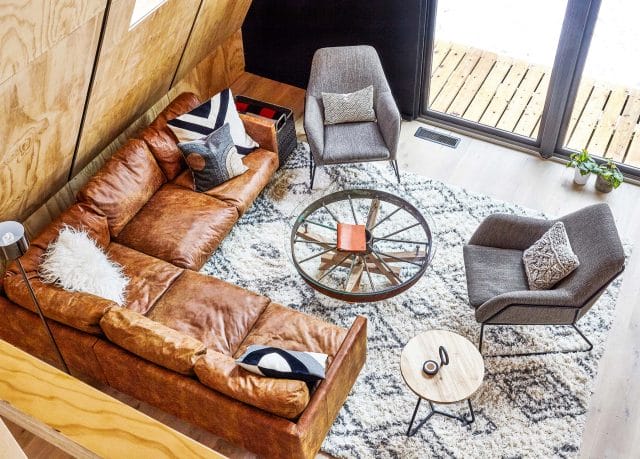
Why does my leather furniture have little spots and marks all over it?
Just like you get mosquito bites after a weekend away at the cabin, cows get bug bites that will appear on their hides. You’re more likely to see these markings on a full aniline sofa than a semi-aniline. These markings are a good reminder that your piece is completely one-of-a-kind with a rich history — and that humans are lucky to have bug spray.
Why are the two chairs I got slightly different in color or texture?
Leather is a completely natural material and as such will show variations in color and texture. Every batch of leather furniture is made up of a different batch of cows. To ensure our leathers stay within a certain color range, we use shade bands — reference scales that reflect color levels — to control the allowable tolerance.
We’d be delighted to send you swatches of our leathers so you can get to know them better. Reach out here to let us know which leathers you’re interested in and where we should send them.
Why is my sofa faded in spots?
Sunlight is a powerful thing. The author of this post turns bright red after three minutes in the sun, and your leather sofa is only slightly more tolerant of direct light. As we described above, sunshine and direct light from lamps or other artificial light sources will cause your leather to fade. This is less likely to happen to pigmented or semi-aniline leathers, and more common in aniline pieces.
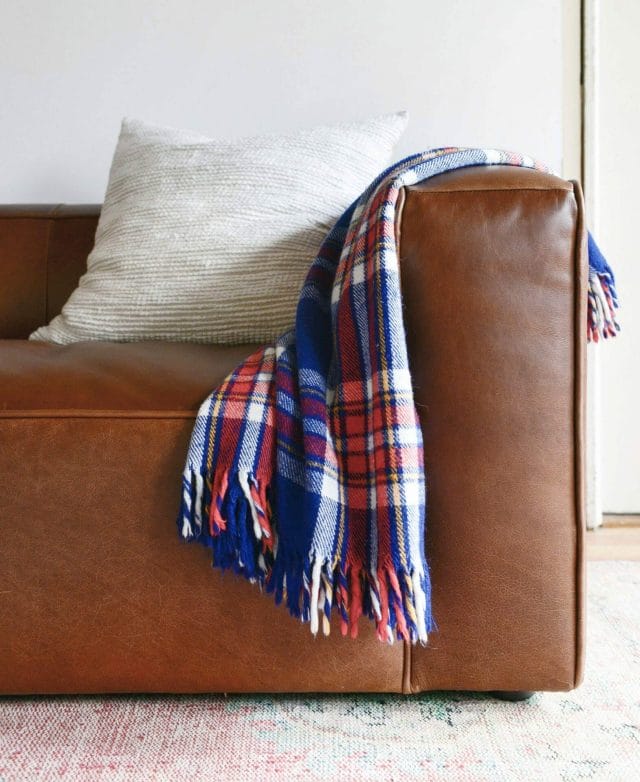
NAILED IT.
Now you’re armed with everything you need to choose what leather furniture is right for you — and keep it looking good for years to come.
So what are you waiting for? Shop the leather of your dreams.

